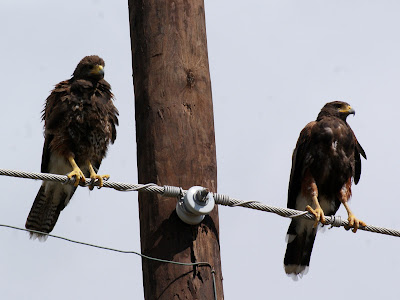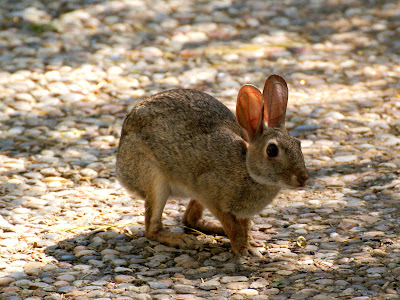.
We started our Sunday birding trip with a visit to Anahuac NWR, a site that we never tire of going to.
Just before we reached the visitor center, I spotted a Common Nighthawk fluttering about on a utility wire.
A second Nighthawk was resting in a nearby tree.
We spent several minutes watching Barn Swallows flying to and from their nests in the old visitor center building.
As usual I tried to get photos of the many Barn Swallows swooping over the pond - and, as usual, I failed! I didn't get a photo, either, of a Green Heron prowling the edge of the pond or of some Brown-headed and Bronzed Cowbirds grazing by the restrooms.
We started along the newly-paved loop road around Shoveler Pond and kept having to stop to admire Killdeer standing over or sitting on their eggs on the road's gravel edges to protect them from the sun.
As I stayed in the car to take photos, most of the Killdeer ignored us. One bird, however, clearly thought we were a threat because it tried to lure us away from its eggs by using its I'm-a-badly-injured-bird routine.
The rest of the loop and the boardwalk had quite a few birds but all were quite a distance from the road: Black-bellied and Fulvous Whistling Ducks, Tricolored Herons, Black-necked Stilts (below), three Least Bitterns, 20+ Forster's Terns (below), several more Green Herons, two Common Gallinules, and lots of Great and Snowy Egrets.
We passed many Eastern Kingbirds, Great-tailed Grackles and Red-winged Blackbirds (below) perched by the roadside.
Surprisingly, we didn't see a single alligator, perhaps because the water level was very high.
On our way out of the refuge, we came across several Scissor-tailed Flycatchers perched on utility wires or in trees. Although they are common in our area throughout most of the year, I never tire of watching and photographing these spectacular wonderful birds.
After our 90 minutes at Anahuac, it was time to head over to High Island. We've learned that the Smith Oaks rookery there is always worth a visit at this time of year.
.
.Since returning from our trip to the Lower Rio Grande Valley, I've been interested in watching the progress of the two pairs of Western Kingbirds that are nesting on the CyFair campus.
The pair that has nested under the roof of the college basketball court for the past 8 years is back there this year. At the moment the female is still sitting on the nest.
The other pair nested in a tree in the parking lots and they have made much faster progress. For a couple of weeks I enjoyed watching the adults bringing food to the nest, which had two young.
The youngsters grew surprisingly quickly.
The adults at this site were much more aware of my presence than the pair at the basketball court has been in past years. I imagine this is because their nest is only 15 feet from the ground and therefore more exposed than the one high in the roof of the basketball court.
One young bird was still in the nest at the end of last week.
However, when I checked Monday morning, the nest was empty. The parents have moved their two juveniles to a location high in a nearby tree.
As the adults seemed agitated when I went over to the tree, I suspect that they will now move their young to another tree.
I can't wait to see how the other pair fares. They raised four young every year until last year, when they raised only three, perhaps because we were in a drought and so the food supply may have been reduced. It will be interesting to see how many they raise this time.
.
.
Sunday morning I arrived at Estero Llano State Park in Weslaco at 7:45. As the park opened only six years ago and I had never visited it before, I was excited to see what it had to offer.
I walked down to the visitor center and was amazed to see hundreds of wading birds on the shallow lake next to the observation deck.
Great and Snowy Egrets, White Ibis, Roseate Spoonbills and Black-necked Stilts were all feeding in the morning sunlight.
There were other birds, too. A juvenile Yellow-crowned Heron was perched near a Great Egret.
The dark plumage of a Tricolored Heron stood out among the white of the egrets.
Laughing Gulls and Black-bellied Whistling Ducks wheeled overhead.
I scanned the water for other birds and found my first Wood Stork of the year next to a Roseate Spoonbill.
Buff-bellied Hummingbirds were busy among the Turk's Cap behind the center while Plain Chachalacas strolled across the building's roof.
There was a bird walk scheduled for 8:30. Since I was early for it, I decided to walk over to the Rio Grande to look for Green Kingfishers. On the way I passed several Great Kiskadees, including a pair with a juvenile.
I scanned the river banks but once more failed to find a Kingfisher.
So I headed back to the visitor center, passing a Purple Martin house that Martins were sharing with House Sparrows.
I was the only person who turned up for the bird walk and so I had the two guides to myself. As we started the walk, we passed Black-crested Titmice, Curve-billed Thrashers, and both Golden-fronted and Ladder-backed Woodpeckers. We saw several Clay-colored Thrushes, including this juvenile.
The guides showed me a Groove-billed Ani sitting on a nest but I wasn't able to get any photos.
Then the guides showed me the nest that was being constructed by a Rose-throated Becard, and extremely rare bird in the USA and a lifer for me. When the guides ended the walk, I stayed behind to watch the nest. After 15 minutes I was rewarded with good looks of the female bird as she fussed around her nest. My photos weren't so good!
I walked back to the parking lot to find an Altamira Oriole sitting on the car's wing mirror. The bird immediately flew up into a nearby tree, where I managed to grab a couple of photos.
Then it was time to head for the motel to pick up Dee before starting the long drive back to Houston. Our trip had gone all too quickly and had involved a lot of driving, but it had certainly been worthwhile. Perhaps we'll do another trip to the Valley in the fall, when it won't be as hot and when we might be able to stay longer. And perhaps next time I'll finally get to see a Green Kingfisher.
.
.
Saturday morning we headed out to visit Laguna Atascosa National Wildlife Refuge, a site that had impressed us on two visits some years earlier and that we were hoping would produce such birds as Harris's Hawks, Green Jays and Greater Roadrunners.
On the way, we stopped at the bridge in Rio Hondo to look for Green Kingfishers. Once again we didn't see any! I hoped this wasn't a bad omen for the day.
Arriving at the refuge, I felt reassured when we almost immediately saw two Harris's Hawks perched by the roadside.
We then parked near the visitor center and sat down for a while at the feeding and watering station there. It was extremely busy with numerous Green Jays, Bronzed Cowbirds and Great-tailed Grackles.
A tree near the visitor center had an Altamira Oriole nest and I got a brief glimpse of an Oriole at the top of another tree.
We explored some of the many pathways and came across a good selection of other birds - Long-billed and Curve-billed Thrashers, Buff-bellied Hummingbirds, Plain Chachalacas and Common Ground Doves.
We saw and/or heard several Golden-fronted Woodpeckers.
A Ladder-backed Woodpecker was a nice change.
Black-tailed Jackrabbits shared the paths with us.
Next we spent a pleasant time in the photo blind. One of the first visitors there was another Jackrabbit. It must have been extremely thirsty because it stayed and drank for over five minutes.
We had good views of birds here, too - including Black-crested Titmice, Common Ground Doves, and a Long-billed Thrasher.
After a quick snack in the parking area, we drove the 15-mile bayside loop, grateful for the strong breeze that was blowing in from the water.
Most of the drive wasn't very productive, as we saw only a few birds and all at some distance: Great Egret, Great Blue Heron, Reddish Egrets, Crested Caracara, Laughing Gulls, Osprey, and Black and Turkey Vultures. Then we came across another of our target birds when two Greater Roadrunners crossed the road in front of us. Unfortunately, I didn't manage to get photos of these birds, or of a javelina (collared peccary) that also crossed the road.
Back at the visitor center the feeding station was even busier than earlier. A couple of Brown-headed Cowbirds and Red-winged Blackbirds had joined the many Bronzed Cowbirds.
Plain Chachalacas came to share in the food and water.
An Altamira Oriole flew in to drink from the hummingbird feeder.
eanwhile Green Jays, Bronzed Cowbirds and Great-tailed Grackles bathed and then preened.
White-tipped Doves were around, too.
Even a Mexican Ground Squirrel also came to visit.
We decided that four hours of birding was enough for the day and so started on the drive back to Harlingen. As we were leaving the refuge we passed several Eastern Meadowlarks and then twice had to stop to check out small birds by the roadside: Lark Sparrows, a species we hadn't seen since moving to Texas from California.
So Laguna Atascosa had turned up trumps again by providing us with a half-day of great wildlife watching.
We were going to drive back to Houston the following day but we agreed that I would first make an early morning trip to Estero Llano State Park in Weslaco. This is a site that we had never visited and where I thought I might see Groove-billed Anis and perhaps my first Wood Storks of the year.
.



























































